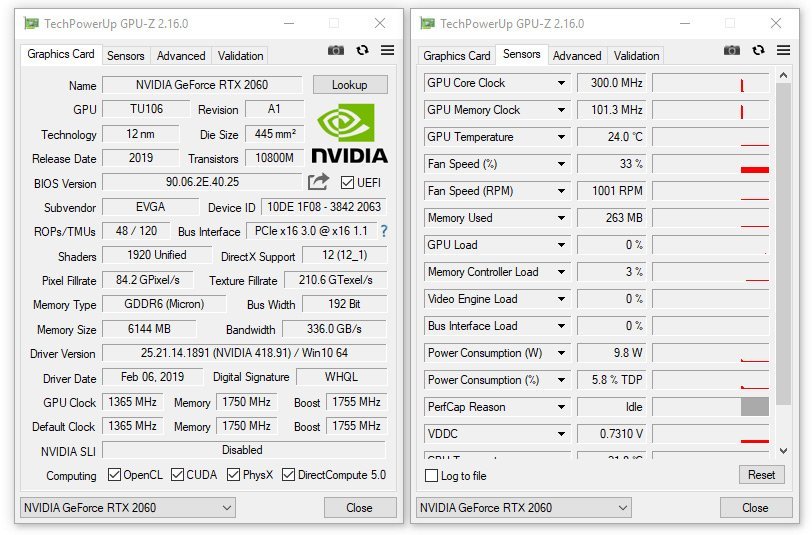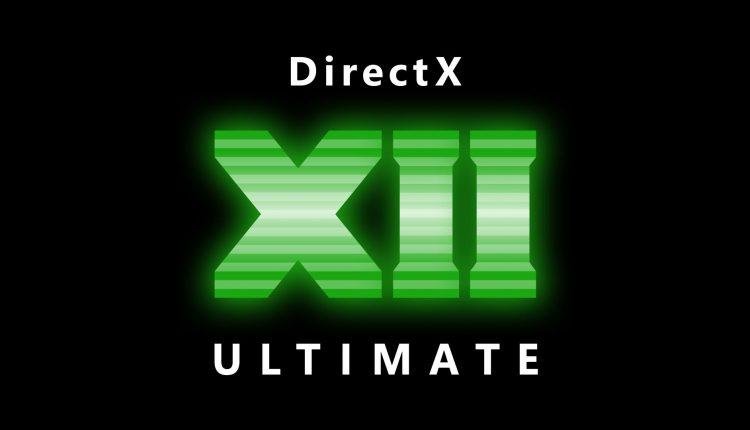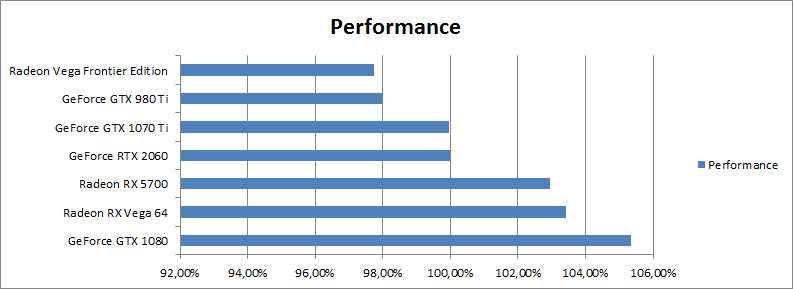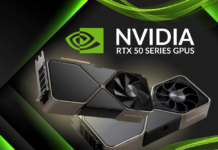The RTX 2060 KO features an NVIDIA Turing . This card supports Ray tracing which is a real graphics revolution. This card is available online for the price of around €370.
RTX 2060 KO Gaming Card Specifications
The RTX 2060 KO card has a GPU with a boost frequency of 1.68 GHz 6 GB GDDR6 memory transmitting data at 14 Gbps. The memory has a bandwidth of 336 GB per second on a 192-bit bus. TU106 GPU includes 1920 CUDA Cores . The TU106 measuring 445 m 2 12 nanometer etching procedure . This graphics card can process 5 Giga Rays per second with its base speed of 1.365 GHz.
However, it should be noted that some RTX 2060 KO EVGA are equipped with a TU104-150 GPU. The performance difference is nevertheless negligible in these cases.

The RTX 2060 KO Gaming supports a host of features such as Ray tracing, Nvidia DSLL 2.0, Nvidia GeForce Experience, Nvidia Ansel, G-Sync, Microsoft DirectX 12 Ultimate, Vulkan API, Nvidia GPU boost, VR Ready, Nvidia Encoder (NVENC)… On the display side, the RTX 2060 KO Gaming has 4 video output connectors: 1 DisplayPort , 1 HDMI , 1 USB-C and 1 DVI-DL . This card can thus support 4 simultaneous screens for a maximum resolution of 7680 x 4320 . It measures 112.6 mm x 228.6 mm, to occupy 2 PCIe slots in width. The card weighs 1.21 pounds, or approximately 550 grams. Since the RTX 2060 KO consumes 160 Watts , it is recommended to have a minimum power power supply of 500 Watts.
The features that make the difference
The new features supported by the new generation of NVIDIA 2000 NVIDIA graphics cards all contribute to the efficiency of the latter. Certain features are however decisive. Ray Tracing is a real revolution in the treatment of graphic effects. It makes it possible to calculate the shadow and light effects of each pixel in the opposite direction: from the position of the camera towards each object then towards the different light sources in the game scene. In this way, the game enjoys a more realistic effect.

The Nvidia GPU boost supported by the RTX 2060 allows you to better boost the GPU depending on the load, the available electrical power and especially the temperature of the chip. Additionally, Nvidia has allowed users to overclock via the Nvidia Scanner . This functionality is available from software from partner manufacturers such as Afterburner from MSI or Precision X1 from Evga. Nvidia allows you to define the maximum stable frequency via this function. The user can also set the TDP power to consume as well as the maximum operating temperature.
The DSLL 2.0 brings its host of advantages to the RTX 2060 card. Deep Learning or super sampling technology allows real-time rendering, optimized by Artificial Intelligence. Frame rates are accelerated by the GPU's Tensor cores and AI processor. This optimizes Ray tracing and provides superior image quality with unrivaled clarity. DSLL 2.0 differs from its first version by providing higher image resolution, using a single AI network for a greater number of games and being able to customize the output image quality (quality , versatility, performance).
So with DSLL enabled, with the RTX 2060, we can for example go from 41.8 FPS to 68.1 FPS on a 1920 x 1080 image resolution.

With the Nvidia GeForce Experience , enjoy up-to-date drivers and features. It also allows you to easily share your gameplay videos on your favorite social networks (YouTube, Facebook, Twitch, etc.) without interfering with the performance of the game in progress. You can also apply customizations to your games in post-processing such as personalized filters . If you want to capture scene photos with your RTX 2060, you can use the Nvidia Ansel . The latter allows you to take screenshots with Super Resolution in 360° in HDR/Stereo.
The RTX 2060 card also supports Microsoft DirectX 12 Ultimate . With the latter, different advantages are obtained to speak only DXR and VRS. DXR shadow and reflection effects. RT cores deliver billions of Rays per second and accelerate frame rates up to 3x in DXR-enabled games and applications. Regarding VRS , this functionality allows you to accelerate the graphics frequencies which are variable depending on the areas of the scene concerned. The sky and the walls do not need very frequent image renewal, for example. The calculation effort will thus be directed towards the areas requiring to display more details.

RTX 2060 configurations and performance
The fact of having been able to manufacture the TU106 with a 12 nm engraving instead of 16 nm for the previous generation makes it possible to accommodate the 10.8 billion transistors in a 445 m 2 . To get a comparative idea, on the GeForce GTX 1060 , the chip contains 4.4 billion transistors, housed in 200 mm 2 . Which does not justify a high density gain. In fact, each RX 2000 generation transistor needs more space than that of an RX 1000 series.
The 1920 calculation units are accompanied by 48 rendering units , 120 texture units , 30 RT units for Ray tracing and 240 tensor units .
RTX 2060 benchmarking
When testing the RTX 2060 card on G3D Mark, it obtains a score of 14,050. It is better than the GeForce GTX 1070 (G3D Mark score 13,309); Radeon RX 5700 XT card which displays a score of 16,710. Here is a comparison graph of different cards on G3D Mark.

The RTX 2060 provides very interesting frame rates for games in QHD resolution and lower. On the Fortnite title, it displays an average frame rate of 72.5 FPS in QHD 1440p. The results are even better at lower resolution: 105 FPS in UHD 1080p, 245 FPS in HD 720p. In 4K, we get an average frame rate of 13 FPS.

Comparing the performance of the RTX 2060 on various benchmarking platforms such as 3DMark, Passmark and SPECViewperf with the closest competing cards, the RTX 2060 is 0.05% faster than the GForce RTX 1070 Ti and -2 .96% less efficient than the Radeon RX 5700 .

In overall performance, the RTX 2060 shows a commendable result. It is in fact 56.01% behind the fastest card during our tests: the GeForce RTX 3090 .
In short, the RTX 2060 card is a higher-end card that displays good performance. It is especially advantageous by supporting new technological feats such as Ray tracing and DLSS. The rating of this card continues to rise. It is available online for around €370.





